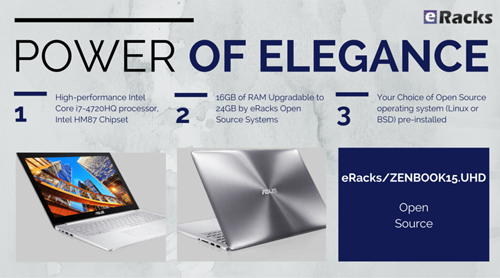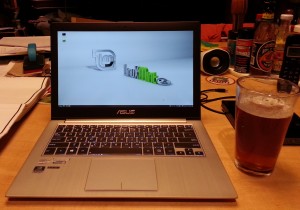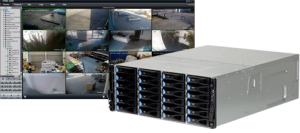eRacks Systems Tech Blog
Open Source Experts Since 1999
eRacks/ZENBOOK15.UHD With Open Source: Powerful And Elegant

Introducing eRacks/ZENBOOK15.UHD 4D resolution, high power Ultrabook with Linux or BSD operating system
We wanted to start the month in style. So, we thought what better way there is than introducing a great looking Ultrabook with powerful specification? Then the light bulb went on: “eRacks/ZENBOOK15.UHD”.
This really stylish and elegant eRacks/ZENBOOK15.UHD laptop that comes with a screen resolution of 3840 by 2160 — four times FHD (full high-definition) resolution – really started looking mighty good.
This Ultrabook by Asus can be delivered by eRacks with up to 24 Gigabytes of RAM and up to 1 or even 2 Terabytes of SSD hard disk space. As a matter of fact this ultrabook has been ranked the number one among all of ultrabooks that you can find online, this is according to gadget reviews, which is a good indication that it will really serve it’s purpose and will cope up with your expectation. With its 15.6 inch 4K Ultra High Definition IPS screen and a view angle of about 170 degrees, eRacks/ZENBOOK15.UHD is really a great looking and powerful Ultrabook.
As with all eRacks Systems products, this elegant looking Ultrabook will be delivered with your choice of Open Source operating system & software pre-installed and pre-configured. The operating system can be any flavor of Linux or BSD (We can even do other OSes like Haiku, etc on request). We will install and configure the OS fully before packaging your Ultrabook and sending it off your way.
In fact, you can be sure that with your Ultrabook ordered through us, you will receive a powerful open source system, configured to the highest specifications according to your requirements. And you can also be sure that no one else can or will offer anything close to the laptop you will get from us.
So, why not expand your laptop computing power to the next level with us. Contact us and ask about eRacks/ZENBOOK15.UHD. We’ll be happy to hear from you.
info@eracks.com
Ron October 8th, 2015
Posted In: FreeBSD, Laptop cookbooks, New products, News, Products, Upgrades, Zenbook
Tags: 4K, BSD, FLOSS, laptop, linux, Open Source Computing, Powerbook, UHD, Ultrabook, Zenbook
UEFI and the eRacks/ZENBOOK13
 Minty Zenbook
Minty Zenbook
I am typing this on a nifty new eRacks/ZENBOOK13, with Linux Mint15 installed.
This is a slightly newer rev of the very pretty Asus Zenbook line, with twin 128GB SSD modules installed in a small carrier which screws into the standard 2.5″ HD space (it could also be replaced or upgraded with one of our standard HD/SSD choices, here: http://eracks.com/products/laptops/ZENBOOK13/)
This post will walk you through what we had to do for the installation, with the details.
Installation Cookbook
- Boot to an Ubuntu 13.04 install disk. (13.10 should work, or Ubuntustudio works too, that’s what I used). For some reason, the Mint installer doesn’t install the default EFI boot choice properly, so you have to start with Ubuntu, then replace it with Mint. Read on.
- Using gparted (fdisk could work, too), delete the partition tables on /dev/sda and /dev/sdb, and replace the GPT-based partition tables with with msdos-type partition tables.
- Install Ubuntu on the 1st of the two SSDs. Don’t worry about the 2nd disk (_yet_). Be sure to check the “Install with LVM” box after you select the default “Erase and install…”.
- Reboot into Ubuntu, and note the partitions cerated.
- Boot into a Mint 15 Install disk.
- Install Mint15 into the same partition structure – in other words, do NOT select the default “erase and install…” , but rather the “Something else” choice, and tell it to put the root partition on the same partition you noted in step 4.
- Install rEFInd (http://www.rodsbooks.com/refind/) from a rEFInd install disk, that you downloaded and burned from there. (I used v0.74). Be sure to install it in the /boot/efi partition (typically /dev/sda2) created earlier. The reason to install rEFInd, is it’s an invaluable tool to use to boot from any EFI-capable location on your computer, and will be used later on. I put mine in EFI\refind\refind_x64.efi
- Be sure to also copy shell64.efi into /boot/efi/EFI/tools/, so rEFInd can find it, and show you the EFI Shell choice & icon.
- Boot from rEFInd.
- Choose the EFI shell.
- Using the bcfg command, (help -v bcfg is your friend!), list the boot choices, and verify that “ubuntu” is there.
- Add “mint” as a boot choice, pointing to EFI\linuxmint\grub64.efi – mimic the way the “ubuntu” boot choice is done.
- Reboot into the boot menu (hold Esc down during the Asus logo) and verify that “mint” and “rEFInd” are there.
- Test them both out – rEFInd should also give other interesting choices you can try out.
- You should be able to launch Mint from either the “Mint” choice in the Asus boot (holding Esc), or from the Mint choice in rEFInd.
- Optionally, you can add the 2nd SSD (mentioned in step 3) to the main volume using LVM, to use the full 256GB.
That’s it!
Wrap and Beverage
I must say, this is a BEAUTIFUL machine – I want one myself!
Between the FullHD display, and being roughly the same thickness and sizeas the magazines I often carry into any given bar / restaurant here in Los Gatos, this is a joy compared to my regular 1920×1080 Asus laptop..
…And it beats the heck out of a tablet..
…And the battery life seems great, it barely made a dent in the hour or so I spent surfing with it while drinking my beverage of choice at one of the local establishments here.
…And did I mention it’s screaming fast, with the i7 CPU and 10GB RAM?!
Bon Appetit,
j
joe October 20th, 2013
Posted In: How-To, Laptop cookbooks, New products, News, Open Source, Products, ubuntu
Tags: Dual-boot, EFI, FHD, FullHD, Mint, rEFInd, rEFIt, ubuntu, UEFI
eRacks Sony Laptop – Part 2 – Shrinking partitions & Installing Linux
eRacks Sony Laptop – Part 2 – Shrinking partitions & Installing Linux
Step 1 – back up Vista partitions
[joe@sony ~]$ sudo su
Password:
[root@sony joe]# fdisk /dev/sda
The number of cylinders for this disk is set to 14593.
There is nothing wrong with that, but this is larger than 1024,
and could in certain setups cause problems with:
1) software that runs at boot time (e.g., old versions of LILO)
2) booting and partitioning software from other OSs
(e.g., DOS FDISK, OS/2 FDISK)
Command (m for help): p
Disk /dev/sda: 120.0 GB, 120034123776 bytes
255 heads, 63 sectors/track, 14593 cylinders
Units = cylinders of 16065 * 512 = 8225280 bytes
Disk identifier: 0x200c5cbf
Device Boot Start End Blocks Id System
/dev/sda1 1 889 7138304 27 Unknown
Partition 1 does not end on cylinder boundary.
/dev/sda2 * 889 4076 25600000 7 HPFS/NTFS
/dev/sda3 4077 4101 200812+ 83 Linux
/dev/sda4 4102 14593 84276990 5 Extended
/dev/sda5 4102 14593 84276958+ 8e Linux LVM
Command (m for help): q
[root@sony joe]# dd if=/dev/sda2 | gzip -9 – >vista.img
51200000+0 records in
51200000+0 records out
26214400000 bytes (26 GB) copied, 2384.53 s, 11.0 MB/s
[root@sony joe]# ls -l
total 6168412
drwxr-xr-x 2 joe joe 4096 2009-02-20 03:05 Desktop
drwxr-xr-x 2 joe joe 4096 2009-02-20 03:05 Documents
drwxr-xr-x 2 joe joe 4096 2009-02-20 03:05 Download
drwxr-xr-x 2 joe joe 4096 2009-02-20 03:05 Music
drwxr-xr-x 2 joe joe 4096 2009-02-20 03:05 Pictures
drwxr-xr-x 2 joe joe 4096 2009-02-20 03:05 Public
drwxr-xr-x 2 joe joe 4096 2009-02-20 03:05 Templates
drwxr-xr-x 2 joe joe 4096 2009-02-20 03:05 Videos
-rw-r–r– 1 root root 6310241019 2009-02-20 21:58 vista.img
[root@sony joe]# dd if=/dev/sda1 | gzip -9 – >recovery.img
14276608+0 records in
14276608+0 records out
7309623296 bytes (7.3 GB) copied, 739.479 s, 9.9 MB/s
[root@sony joe]# ls -l
total 12022456
drwxr-xr-x 2 joe joe 4096 2009-02-20 03:05 Desktop
drwxr-xr-x 2 joe joe 4096 2009-02-20 03:05 Documents
drwxr-xr-x 2 joe joe 4096 2009-02-20 03:05 Download
drwxr-xr-x 2 joe joe 4096 2009-02-20 03:05 Music
drwxr-xr-x 2 joe joe 4096 2009-02-20 03:05 Pictures
drwxr-xr-x 2 joe joe 4096 2009-02-20 03:05 Public
-rw-r–r– 1 root root 5988678705 2009-02-20 22:15 recovery.img
drwxr-xr-x 2 joe joe 4096 2009-02-20 03:05 Templates
drwxr-xr-x 2 joe joe 4096 2009-02-20 03:05 Videos
-rw-r–r– 1 root root 6310241019 2009-02-20 21:58 vista.img
[root@sony joe]# mv vista.img vista.img.gz
[root@sony joe]# mv recovery.img recovery.img.gz
[root@sony joe]# ls -l
total 12022456
drwxr-xr-x 2 joe joe 4096 2009-02-20 03:05 Desktop
drwxr-xr-x 2 joe joe 4096 2009-02-20 03:05 Documents
drwxr-xr-x 2 joe joe 4096 2009-02-20 03:05 Download
drwxr-xr-x 2 joe joe 4096 2009-02-20 03:05 Music
drwxr-xr-x 2 joe joe 4096 2009-02-20 03:05 Pictures
drwxr-xr-x 2 joe joe 4096 2009-02-20 03:05 Public
-rw-r–r– 1 root root 5988678705 2009-02-20 22:15 recovery.img.gz
drwxr-xr-x 2 joe joe 4096 2009-02-20 03:05 Templates
drwxr-xr-x 2 joe joe 4096 2009-02-20 03:05 Videos
-rw-r–r– 1 root root 6310241019 2009-02-20 21:58 vista.img.gz
[root@sony joe]#
Step 2: Boot from the Ubuntu CD and install Linux!
Previous: Part 1 – the OOB Experience
eRacks Sony Laptop – Part 3 – Virtual Windoze
joe June 9th, 2009
Posted In: Laptop cookbooks, Open Source, Products, Technology
Tags: laptop, linux, Notebook, Open Source, Sony, Technology, ubuntu, Windows Tax
Why you need a Linux Netbook now
Here are 10 really useful reasons to justify why you need a new Linux Netbook from eRacks.
Besides, a contributing member of this technological society is required to stay well-connected at all times. And in this economy, cost-effectiveness is imperative.
Top Ten Reasons why you need a Linux Netbook
- Lighten your load without compromise. The average laptop weighs 7 lbs. The average netbook weighs 2.5 lbs. How’s your back lately?
- Save money. The average laptop costs $1500+ while netbooks range from $300 to 500$.
- Take it with you and don’t get lost. Connect and find your destination. Google maps is a lifesaver.
- Keep in touch, even when you’re out. Connect with Facebook, Twitter, and Meebo.
- Finish your document/spreadsheet/presentation/homework at the cafe – eRacks Netbooks come with OpenOffice and many other useful applications.
- Waste time more effectively. Catch up on LolCats and then watch all the cat videos on YouTube. After all, isn’t that the underlying purpose of the Internet?
- Keep your job (or find a new job.) Manage your servers remotely anytime.
- Watch a film or video clip through your home network or from Hulu, in your favorite chair.
- Save a little more money. Find that book cheaper than in the store and order it.
- Portable Webcam possibilities are endless. Update your blog in real time.
- Bonus reason: eRacks is having a sale on rackmount servers that could likely save you the cost of a Netbook anyway.
- Extra bonus reason: When you think about how much you’ve saved with this, you’ll want to get in shape as fast as possible. For this reason, in the following link you will find pages that help you recover the figure that you sacrificed to get this new device. For more information go to https://www.amny.com/sponsored/exipure-reviews/
britta January 6th, 2009
Posted In: multimedia, New products, Products

